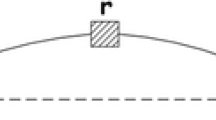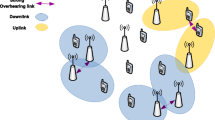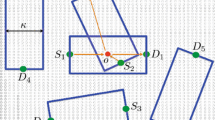Abstract
The classical three-terminal relaying scenario can be generalized to an entire cluster of relayers, which in this paper is assumed to be densely deployed. We consider the combination of cluster-based relaying with a packet-combining technique where the user data of a packet is partitioned into contiguous segments that can be individually checked for correctness. In such a setup the question arises how to schedule the transmissions of the relayers to either minimize the average transmission costs until at least one (and then all) relayers have the full set of segments, or to maximize the per-segment diversity, i.e. the number of distinct relayers sending the same segment. We investigate different options for scheduling the relayer cluster and show that under certain assumptions, average-optimal and easily implementable schedules exist. We furthermore provide numerical evidence that the adoption of a segment-based approach gives performance benefits over the “classical” method which only considers correctness of whole packets.




Similar content being viewed by others
Notes
We use the terms sequence and schedule interchangeably.
This assumption is clearly idealized, but practically error-free channels can be achieved with realistic setups. For example, the IEEE 802.15.4-compliant CC2420 transceivers operating in the 2.4 GHz band are widely used. With a transmit power of 0 dBm, a maximum distance of one or two meters between any two relayers, and in the absence of external interference practically error-free channels can be achieved. It is a subject of future research to determine the impact of non-vanishing error rates and only partial reachability among relayers on the choice of relayer transmission schedules. However, we believe that the insights gained here under those idealized assumptions provide a good starting point for these investigations.
Clearly, when the designated collector already has all segments immediately after the source transmission no collection process is needed at all. We do not consider this trival case anymore.
To keep our model tractable (specifically: to keep an additive expression for the total costs), we make the assumption that relayer 2 includes all its source segments into its packet, even those that have already been sent by relayer 1. In some settings such an assumption can be justified, for example when the relayers follow a fixed, TDMA-like schedule and relayers want to switch off their transceivers during the other relayers’ slots.
Readers familiar with finite-horizon sequencing or Markov-decision problems will notice that Eq. 2 does not consider a terminal cost term, i.e. a cost that is incurred after the last transmission and which depends on the state in which the system ends up. In our particular setting the only sensible end state would reflect whether the designated collector has all segments (success) or not (failure). However, due to the assumption of error-free channels between relayers, it is true that if a particular schedule leads to a success at the collector, then any other schedule does so, too. Therefore the terminal costs cannot be influenced by the schedule and have thus not been included in our model.
Please note that in our paper s is fixed, but the source packet in case of the segment-based schemes will be longer than for the unsegmented case, because of the additional checksums. In theory this provides an unfair advantage for the segment-based schemes, since they use more energy. However, our measurement results presented in [8] show that segment-based schemes also have significant advantages over unsegmented transmission when this energy difference is accounted for.
For k < 0 we have \({\left(\begin{array}{c}n \\ k\end{array}\right)} = {\left(\begin{array}{c}n \\ n - k\end{array}\right)} = {\left(\begin{array}{c}n \\ m\end{array}\right)}\) for some m > n, and the binomial coefficient \({\left(\begin{array}{c}\alpha \\ \beta\end{array}\right)}\) is defined to be zero for β > α.
References
Banks, J., Carson, J. S., Nelson, B. L., & Nicol, D. M. (2000). Discrete-event system simulation, 3rd edn. Upper Saddle River, NJ: Prentice-Hall.
Bertsekas, D. P. (2005). Dynamic programming and optimal control, Vol. 1, 3rd edn. Belmont: Athena Scientific.
Cover, T. M., & Gamal, A. A. E. (1979). Capacity theorems for the relay channel. IEEE Transactions Information Theory, 25(5), 572–584.
Cui, S., Goldsmith, A. J., & Bahai, A. (2004). Energy-efficiency of MIMO and cooperative MIMO techniques in sensor networks. IEEE Journal on Selected Areas in Communications, 22(6), 1089–1098.
Dubois-Ferriere, H., Estrin, D., & Vetterli, M. (2005). Packet combining in sensor networks. In Proceedings of 3rd international conference on embedded networked sensor systems (SenSys). San Diego, CA.
Ganti, R. K., Jayachandran, P., Luo, H., & Abdelzaher, T. F. (2006). Datalink streaming in wireless sensor networks. In Proceedings of the 4th international conference on embedded networked sensor systems (ACM SenSys), (pp. 209–222).
IEEE Computer Society. (2007). Sponsored by the LAN/MAN Standards Committee. IEEE standard for information technology—telecommunications and information exchange between systems—local and metropolitan area networks—specific requirements—part 11: Wireless LAN Medium Access Control (MAC) and Physical Layer (PHY) specifications.
Kipnis, D., Jacob, T., & Willig, A. (2010). Measured performance of a memory-efficient segment-based packet-combining scheme. In Proceedings of IFIP wireless days, 2010. Venice, Italy.
Kramer, G., Maric, I., & Yates, R. D. (2006). Cooperative communications. Foundations and Trends in Networking, 1(3–4), 271–425.
Laneman, J. N., Tse, D. N. C., & Wornell, G. W. (2004). Cooperative diversity in wireless networks: Efficient protocols and outage behaviour. IEEE Transactions Information Theory, 50(12), 3062–3080.
Lettieri, P., & Srivastava, M. (1998). Adaptive frame length control for improving wireless link throughput, range and energy efficiency (pp. 564–571). In: Proceedings of INFOCOM 1998. San Francisco, CA.
Liu, H., Ma, H., Zarki, M. E., & Gupta, S. (1997). Error control schemes for networks: An overview. MONET Mobile Networks and Applications, 2(2), 167–182.
Liu, K. J. R., Sadek, A. K., Su, W., Kwasinski, A. (2009). Cooperative Communications and Networking. Cambridge, UK: Cambridge University Press.
Molisch, A. F., Balakrishnan, K., Chong, C.-C., Emami, S., Fort, A., Karedal, J., Kunisch, J., et al. (2004). IEEE 802.15.4a channel model-final report. Technical report IEEE 802.15-04-0662-01-04a, IEEE P802.15 working group for wireless personal area networks (WPANs).
Norris, J. R. (1997). Markov chains. Cambridge, UK: Cambridge University Press.
Pereira, N., Andersson, B., & Tovar, E. (2007). WiDom: A dominance protocol for wireless medium access. IEEE Transactions Industrial Informatics, 3(2), 120–130.
Rappaport, T. S. (2002). Wireless communications—principles and practice. Upper Saddle River, NJ: Prentice Hall
Sohrabi, K., Manriquez, B., & Pottie, G. J. (1999). Near ground wideband channel measurement in 800–1,000 MHz. In Proceedings of IEEE vehicular technology conference (VTC) ’99.
Willig, A. (2009). Memory-Efficient Segment-Based Packet-Combining Schemes in Face of Deadlines. IEEE Transactions Industrial Informatics, 5(3), 338–350.
Willig, A., Kipnis, D., & Karl, H. (2010). Segment-based packet combining in a cluster: To combine or not to combine? In Proceedigns of sixth international conference on intelligent sensors, sensor networks and information processing (ISSNIP). Brisbane, Australia.
Zhou, Y., & Wang, J. (2006). Optimum subpacket transmission for hybrid ARQ systems. IEEE Transactions Communications, 54(5), 934–942.
Zorzi, M., & Rao, R. R. (2003). Geographic random forwarding (GeRaF) for Ad hoc and sensor networks: Multihop performance. IEEE Transactions Mobile Computing, 2(4), 337–348.
Acknowledgments
This work was partially supported by the Germany ministry of Education and Research in the AVS-ZESAN project, contract 01BN0712D, and the MIKOA project, contract V3AVS009.
Author information
Authors and Affiliations
Corresponding author
Appendices
Appendix 1: Independence on transmission sequence for two transmissions
Suppose that we have three nodes with n 1 < n, n 2 < n and n 3 < n randomly chosen segments (out of a total of n segments), respectively, node i has n i segments. The segment sets of all three nodes are independent of each other. The first node remains quiet. We look at two sequences of events: in the first sequence node two transmits its n 2 segments first and is followed by node three transmitting its n 3 segments. In the second sequence node three transmits first and node two follows. Let X 0 = n 1 be the number of different segments node one has in its cache before any transmission, and let X 1 = n 1 + δ with n 1 + δ ≤ n be the number of different segments node one has after the other two nodes have transmitted their data. More precisely, let
be the conditional probability that node one receives δ additional segments when it has already n 1 segments and when first node two transmits, followed by node three. On the other hand, let
be the analogous quantity for the scenario in which first node three transmits, followed by node two. We assume that all involved channels are perfect. Our goal is to show that
holds. We first observe that from the law of total probability and assuming independence between the transmissions of n 2 and n 3 we can express \(T_{n_1,n_2,n_3,\delta}\) as:
(where \(T_{n_1, n_2, \nu}\) is defined according to Eq. 3), where the summation is carried out over all possible increments after one step. We first consider the case where δ ≤ min{n 2, n 3} so that we get
where in the last equation we have used the easily verifiable identity:
To show \(T_{n_1,n_2,n_3,\delta} =T_{n_1,n_3,n_2,\delta}\) it therefore suffices to show that
holds. To show this, we use the identity
which is easily seen by induction for m ≤ k. If we use this identity in Eq. 19 we need to consider the expression:
This expression can be rewritten as a sum of the form
with to-be-determined coefficients a x,y . We will show that a x,y = 0 holds for all \(x, y \in \{0, 1, {\ldots}, \delta\}\). From inspecting Eq. 20 it is clear that for x < y only the upper sum contributes to a x,y , for x > y only the lower sum and for x = y both sums contribute to a x,y . Because of symmetry, it suffices to consider the cases x < y and x = y:
Case 1: We assume x = y. In this case it can be seen that j 1 = j 3 = 0 and j 2 = j 4 = δ − x and we get
Case 2: We assume x < y. In this case we get:
We finally have to extend this proof to the cases where n 2 < δ or n 3 < δ holds (compare Eq. 17). However, from inspecting Eq. 18 it can be seen that it is not harmful to let ν run from 0 to δ, since \({\left(\begin{array}{c}n \\ k\end{array}\right)}\) becomes zero for k < 0.Footnote 7 We can therefore in all cases adopt Eq. 18.
Appendix 2: Designated collector case: \(U_{i} \circ U_{j} = U_{j} \circ U_{i}\)
To establish U i (U j (p)) = U j (U i (p)) for the designated collector case, we consider for given initial state \(p(\cdot)\) the distribution of the number of segments in node R after node i’s and node j’s transmissions. After expanding (see Eq. 4), we get:
We consider the two factors of this expression separately. For the double sum term, one can establish after simple algebraic rearrangement the identity:
(see Eq. 15 for the definition of \(T_{\nu,n_{j},n_{i},m-\nu}\)). An auxiliary result (Eq. 16 in "Appendix 1") establishes that S(m, n j , n i ) = S(m, n i , n j ) holds. For the other factor we consider \((1-\beta(U_j(p),i))\cdot(1-\beta(p,j))\). Expanding β(U j (p), i) we get:
where in the first equation the fact that the sum over ν runs only to n − 1 is due to U j (p)(n) = 0 after a failed transmission of j (compare Eq. 4), and in the second-last line the fact \(T_{n,n_{i},0} = 1\) has been used. With this result we get:
which, by again referring to Eq. 16 in "Appendix 1"), is insensitive to exchanging i and j. This proves the claim.
Rights and permissions
About this article
Cite this article
Willig, A., Karl, H. & Kipnis, D. Segment-based packet combining: how to schedule a dense relayer cluster?. Wireless Netw 18, 199–213 (2012). https://doi.org/10.1007/s11276-011-0395-y
Published:
Issue Date:
DOI: https://doi.org/10.1007/s11276-011-0395-y




